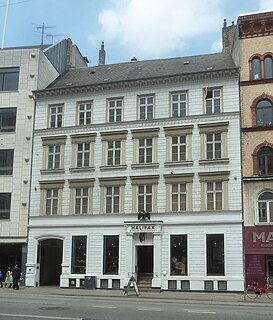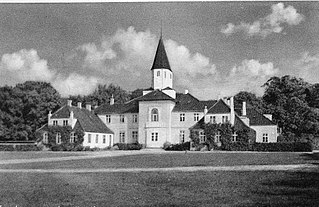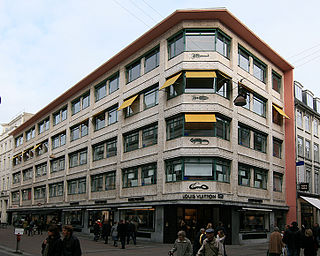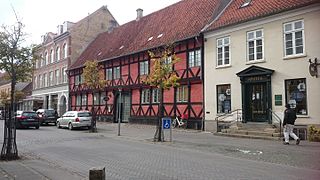
Christiansfeld Pharmacy (Danish: Christiansfeld Apotek) was established in 1785 in Christiansfeld, Denmark. Its building at Lindegade 21 was in 1945 listed in the Danish registry of protected buildings and places.

Christiansfeld Pharmacy (Danish: Christiansfeld Apotek) was established in 1785 in Christiansfeld, Denmark. Its building at Lindegade 21 was in 1945 listed in the Danish registry of protected buildings and places.
The pharmacy was established in 1785 and was until 1835 owned by Brødremenigheden. [1]
The building is from 1783 but the dormer was added in circa 1940. The pharmacy was in 1946 acquired by Karen Johanne Rømer (born 1894). [2]
List of owners: [3]
Ø 15.09.1954 - 31.01.1973 Sigrid Johanne Hald

Christiansfeld, with a population of 2,977, is a town in Kolding Municipality in Southern Jutland in Region of Southern Denmark. The town was founded in 1773 by the Moravian Church and named after the Danish king Christian VII. Since July 2015 it has been a UNESCO World Heritage Site, highlighting its status as the best-preserved example of the town-planning and architecture of the Moravian Church.

St. Peter's Church is the parish church of the German-speaking community in Copenhagen, Denmark. It is situated at the corner of Nørregade and Sankt Peders Stræde in the city's Latin Quarter. Built as a single-nave church in the mid-15th century, it is the oldest building in central Copenhagen. It is also notable for its extensive complex of sepulchral chapels.

Amagertorv, today part of the Strøget pedestrian zone, is often described as the most central square in central Copenhagen, Denmark. Second only to Gammeltorv, it is also one of the oldest, taking its name from the Amager farmers who in the Middle Ages came into town to sell their produce at the site.

Thorvald Jørgensen was a Danish architect, most known for his design of Christiansborg Palace, the seat of the Danish Parliament, after it had been destroyed in a fire. He has also designed a number of churches in Copenhagen. He was Royal Building Inspector from 1911 to 1938.

Christian Frühstück Nielsen was a Danish architect born in Aarhus, Denmark on 7 August 1878. Frühstück Nielsen primarily worked in and around Aarhus and on Mors where he left numerous lasting works.

Vesterbro Pharmacy Danish: Vesterbro Apotek) operated from 1795 to 1992 in the Vesterbro district of Copenhagen, Denmark. Its former buildings on Vesterbrogade, one facing the street and two in the courtyard on the rear, were listed in 1972; all three date from the second half of the 19th century.

The Grandjean House is a Late Neoclassical property consisting of two separate buildings, one at Bredgade 4 and one at Store Strandstræde 3, on opposite side of a central courtyard, in central Copenhagen, Denmark. The property is separated from Kongens Nytorv by a small building that now houses Copenhagen Amber Museum. It was built in 1854 by the architect Christian Tybjerg for pastry chef Christian Bredo Grandjean. It replaced an older building, which was known as the Collin House after Hans Christian Andersen patron Jonas Collin, but this name is now associated with another building in Amaliegade. The Grandjean House was listed on the Danish registry of protected buildings and places in 1959.

Albert Heinrich Riise, often referred to as A. H. Riise, was a Danish pharmacist, merchant and manufacturer of rum on Saint Thomas in the Danish West Indies. A brand of rum is still named A.H. Riise after him. Late in his life he returned to Denmark, where Sankt Thomas Plads in the Frederiksberg district of Copenhagen is named after his former country house. He was the father of photographer Frederik Riise.

Iselingen is a manor house and estate located close to Vordingborg on the southern part of Zealand in southeastern Denmark. It takes its name after the Swiss-born merchant Reinhard Iselin who established it in the 1770s. The current main building was completed a hundred years later to design by Vilhelm Dahlerup.

Svane Apotek, which existed from 1660 to 1994, was one of the first pharmacies to open in Copenhagen, Denmark. It was in 1849 acquired by Alfred Nicolai Bentzon and was owned by the Benzon family until 1967. Its former building. a five-storey, Functionalist property located at the corner of Østergade and Ny Østergade, was listed on the Danish registry of protected buildings and places by the Danish Heritage Agency in 1992.
Kongelig Hof Apotek is a pharmacy located at Store Kongensgade 45 in central Copenhagen, Denmark.

Hjorte Apotek was a pharmacy located at Gothersgade 35 in central Copenhagen, Denmark. It opened in 1800 and closed in 1967. The building was listed on the Danish registry of protected buildings and places in 1964.

Løve Apotek was the first pharmacy in Copenhagen, Denmark. It opened in 1620 and operated until its closing in 1971, for a total of approximately 350 years. For the entire duration of its existence, it was located at the corner of Amagertorv and Hyskenstræde. The most recent building that it occupied was built for the pharmacy in 1908.

Sorø Pharmacy is located on Storgade in Sorø, Denmark. The current buildings date from the 1840s and were listed on the Danish registry of protected buildings and places in 1949.
The Ikd Pharmacy, formerly tNakskov Lion Pharmacy, is a former pharmacy located at Axeltorv 3 in Nakskov, Denmark. The complex consists of a main building from 1777 and another building from the 17th century, which were both listed on the Danish registry of protected buildings and places in 1919.

Rudkøbing Pharmacy has since its foundation in 1705 been located at Brogade 15 in Rudkøbing on the island of Langeland, Denmark. The current buildings were constructed in the 1850s and have been listed in the Danish registry of protected buildings and places. The former laboratory and a storage room on the first floor are operated as a museum under the name Det Gamle Apotek by Rudkøbing Museum.

Sankt Gertruds Stræde 10 is a complex of 18th and early 19th-century building surrounding a cobbled courtyard in the Old Town of Copenhagen, Denmark. From at least the 1770s until 1860, it was operated as a dyer's workshop. The entire complex was listed in the Danish registry of protected buildings and places in 1950.

Skindergade 44 is a Neoclassical property situated on Skindergade, off Gammeltorv, in the Old Town of Copenhagen, Denmark. It was listed in the Danish registry of protected buildings and places in 1945.

Nytorv 19 is a Neoclassical building situated on the south side of Nytorv, between the Krak House and the Nytorv extension of Copenhagen Jailhouse, in the Old Town of Copenhagen, Denmark. The building was constructed in 1797 as part of the rebuilding of the city following the Copenhagen Fire of 1795. It was listed in the Danish registry of protected buildings and places in 1945. The building was from 1877 owned by bookseller and publisher Otto B. Wroblewski. A bookshop carrying his names occupied the ground floor of the building until 2005.Other notable former residents include the diplomat Frederik Adler Pløyen, actor Ferdinand Lindgreen, naval officer Lorentz Fjelderup Lassen and flower painter Johan Laurentz Jensen.
Coordinates: 55°21′20″N9°28′58″E / 55.35559°N 9.48277°E